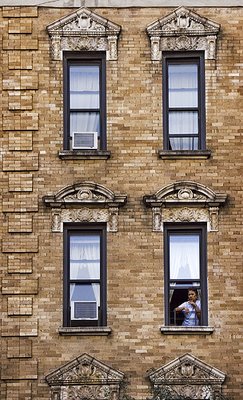
Image source, "Your Guide" on Flickr
I spent the beautiful Saturday walking through East Harlem getting a crash course in the redevelopment of the Marcus Garvey neighborhood with a few other bloggers. Thankfully, the tour came from an affordable housing point of view and frankly, it's about time - with all the triple-mint, XXX R.E. pornography going on these days. A big thank you to Aaron of Starts and Fits (and of HDC, the city's financing unit for multi-unit affordable housing) for the day.
To give us a broad sense of the hockey-stick acceleration of development in East Harlem, Aaron took us around at some stand-out buildings that mark the progression, not all funded by HDC.
East Harlem had a slower uptake at first. When Maple Plaza (c. 1998/1999) and Maple Court (c. 1995), the first stop on our tour at 124th and Madison were being developed, the real estate market was still a bit slow and the area was considered exceptionally "market-risky" with street after street of empty lots and the Metro-North tracks running above ground, bifurcating the neighborhood and punctuating the atmosphere. In these early buildings, you can see the difficulty in shedding some of the old hallmarks of "affordable housing," with the set-backs, especially of the entrance; the tall iron fence that surrounds the building; spare use of windows; and no ground floor amenities. Though Maple Plaza and Maple Plaza are full-lot developments (preferable by developers, makes their job easier), they did receive an upgrade in their design: they are U-shaped, with a courtyard in the middle, instead of being a monolithic block.
For low-income household home ownership purposes, they were an incredible success. The buildings were limited equity co-operatives, which meant that the city sold them at low prices, but bundled mortgage payments with the monthly maintenance fees. The multi-bedroom apartments came with a now inconceivable price, averaging $7,000 per unit. Any proceeds from future sales must be split with the city.
Those were definitely the earliest buildings. As we walked through the years, each successive building demonstrated greater trust in human nature. Instead of designing out of fear, the designs started to come out to meet the street some more, utilized materials that reflected the urban fabric, would incorporate older buildings into the development, and start providing ground-floor retail and more windows. By the time we reached the 2004 mark, we were inside 1400 on Fifth, one of the first green multi-family buildings in the city. Here, the hallmarks of affordable housing had switched from tall perimeter fences to energy-saving features such as geo-thermal heating and fresh-air pumping and a semi-permeable parking lot to mitigate stormwater run-off.
At this point, developers and the city were feeling more creative about financing models. 1400 on Fifth is also a mixed-income building, with some apartments available at market rate and others subsidized by the city.
The overall lingering impression of the neighborhood around Marcus Garvey is that this is a vast improvement over street after street of empty lots or abandoned buildings that was stimulated by the renaissance that started at 125th street (our tour took us from 124th to 116th). As for the negative effects of such accelerated change (e.g., city-instigated gentrification) it's hard to say based on this short tour. For all new city-subsidized multi-family buildings, there is a deliberate process to stem the tide of gentrification. About 50% of units are set aside for community residents first, to be determined by lottery. Within that group, there are also preferences for the disabled, veterans or city workers.
So, who's behind the change? That was even harder to pinpoint. There is definitely a backlash to the government being the developer (think of all those huge housing towers that Jane Jacobs bashed), so the practice now is that the city waits for developers to approach them for development. No proposals are cultivated by HDC per se - they just review proposals sent to them by developers. Without the HDC and HPD and DCP coordinating at this high-level, and with the housing market the way it is, the prevailing "given" is that luxury housing would dominate new developments.
But what about looking at each block and understanding the nuances of the street, the sidewalk, the neighborhood and the community? Zoning practices today reflect more and more an awareness of diverse uses within a single block (the re-zoning plan I know more of is the recently passed Williamsburg-Greenpoint waterfront plan), but this is still a very new practice and zoning is a somewhat crude instrument. There remains no daily coordination between agencies for screening land-use decisions and the erasure of nuance is apparent in the City Planning Commission's reports. Just because you say that a sidewalk should be added to a proposal doesn't mean the sidewalk will actually take you anywhere.
I'm not advocating for bigger government and micro-design and management of city blocks. I am simply suspect of too many decisions being left to market forces because the driving incentive there is profit and a city is not meant to be designed for profit. At balance, a city should be designed for the public good. Like the pioneering green building whose windows have shifted and need to be reset, new ideas need their test of time. They shift and evolve when first practiced and may need to be reset. At the current pace of development, we aren't stopping for a second.
For more on affordable housing in New York City, check out the eponymous Gotham Gazette, edited by Jonathan Mandell who was on the tour with me.
4.30.2006
Housing and rapid change around Marcus Garvey Park, East Harlem
Posted by Shin-pei at 11:07 AM 0 comments
Gathering for Jane Jacobs

From Lisa at Polis,
The consensus is to meet at the White Horse Tavern at Hudson and W. 11th. So let's do that for a happy hour drink on Tuesday (a week after her death), May 2 at 6:00 at the elbow of the bar in the front room (if it's nice, we can move outside). Bring something with you (a favorite passage from Death and Life, flowers to lay at 555 Hudson, or whatever inspires you). Pass this along.See you there.
Posted by Shin-pei at 10:50 AM 0 comments
4.28.2006
Independent America Screening
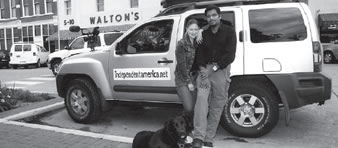
I'm a bit late with this, but I did end up going to the Independent America screening at Pioneer Theater, the perfect place to screen it.
The film has a great concept - driving cross country taking only local highways (no super highways) and stopping/eating/sleeping at only independent mom and pop stores. A former intern happened to be in NY and happened to be doing just this very thing, only his route is from Ohio to the Atlantic Ocean up to Canada and back to Ohio (I think) - and he came to the screening with me. We both thought the movie was fun - less shrill than other anti-big box movies (my opinion) and therefore perhaps more palatable for people who are on the fence about the effect of corporate chains. Who could ever say that they don't like mom-and-pop's? And anyone who had seen Greenwald's "The High Price of Low Cost" won't be more enlightened by the Wal-Mart reveals.
Both Heather Hughes and Hanson Hosein are much more articulate than your average on-the-roadsters, a reflection of their network journalism days. It would have been nice to see more of the evolution of their relationship throughout the movie. It's clear that being on the road, driving relatively slow (compared to interstates) and being limited to only independents is a foil to how the counter-trend might impact so many families across America who have choices limited by the proliferation of corporate chains and mass commuting patterns.
Posted by Shin-pei at 11:21 PM 0 comments
4.26.2006
In memorium
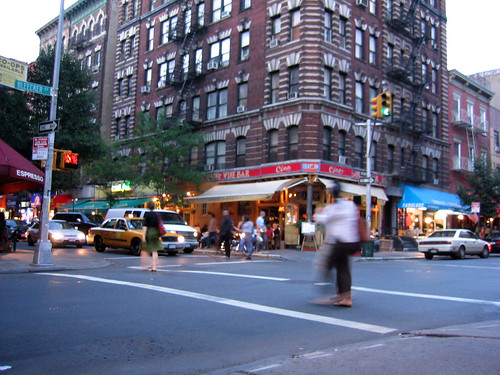
Image from Flickr, Brunocerous
Courtesy of Polis: There's a call to gather at 555 Hudson, where Jane Jacobs lived and wrote the canonical Death and Life of Great American Cities. Drop Polis a line if you're interested.
If that's not your style, Polis and Curbed have partnered for a "Best Jane Jacobs Block in NYC" contest. Details here.
I would add one more element to the list of Jane Jacobs virtues: to be aware of the small details, the interplays, the "unpredictables" - once you think there is a formula, its merit diminishes. Things that you thought unimportant may just be the lynchpin to the success of the block. The beauty of street photography, if you look at enough photos, is that those little details come out in ways that sometimes escape our human eye when we're in the middle of the activity.
Posted by Shin-pei at 10:51 AM 0 comments
4.25.2006
Jane Jacobs, 1916 - 2006

Jane Jacobs has influenced so many. While working in the private sector, it was her "Death and Life of American Cities" that made me feel that critical thinking and engagement with the development of our cities was possible for someone like me, who had no exposure to or "professional" background in urbanism.
Her legacy lives on as cities continue to struggle with the balance of big vs. small-scale as they work towards livability and economic vitality. On a even more tangible level, I feel her presence with each recent graduate that writes to tell me, I want to make our cities and our lives better.
Toronto Star on the life of Jane Jacob.
Posted by Shin-pei at 3:45 PM 0 comments
Car shapes help take over parking
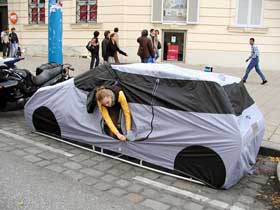
There's been a lot on taking over parking spots in New York and across the country. Do car-shaped tents help? Michael Rakowitz's new project, P (LOT), takes over parking spaces - this time with car-shaped tents. You can get in on the fun too - the tents are rentable at the Museum of Modern Art in Vienna.
Posted by Shin-pei at 12:18 PM 1 comments
Shoppertainment, lifestyle ctr, in our own backyard

at this point, I'm not sure if the nomenclature is really all that important. I forget that we are surrounded by these said structures - they're not in far-flung places. Like any girl, I like my outlet shopping, but the phenomenon of experiential shopping + lowbrow (outlets) + highbrow (premium goods) is mutating, and Lisa Selin Davis who has been featured on these pages offers a critical analysis of American Manhasset Mall in Long Island for Plenty. She writes
The idea is to build community, to recreate the public, lively nature of a real downtown. But this is, of course, an illusion. The "street" is very much maintained by a private entity, and exclusivity is integral to the lifestyle center. If the three-level malls of the 1990s went from low- to high-brow, a sort of cruise ship model with the steerage-class cheapo stores at the bottom level and the high-end boutiques at the top, then the lifestyle center goes a step further, excluding the steerage class altogether. It's a kind of shopping segregation; affluence, after all, is one of the ICSC's main criteria for a lifestyle center.All of this goodness via theboxtank.
Posted by Shin-pei at 12:04 PM 0 comments
4.24.2006
Inaugural "Places to Be": April 24

Image: New Partisan
Writing for BTTN and as a former marketing director, I'm on the receiving end of a lot of cool events from all sorts of different organizations in New York - and happily. As city-folk, we're all inundated with invites, especially in this field of planning, development, urbanism and design (one impressive calendar listing I received last month felt like it was about 50 events long, and does anyone actually go through the AIA one?)
To cut through all of it, I thought I'd start a Places to Be edition, a weekly listing of a few but choice events that address the issue of place in an interesting way, with a preference for the free and public. Think of this as my vicarious social calendar. So, keep those events coming, and here's the inaugural issue, out to you by Tues PM from now on:
THURSDAY, APR 27
I posted (sorry, the image has changed) about the making of Independent America last summer, where two journalists documented their drive across the country on local roads and stopping only at mom-and-pop places. The film premiere will be at Pioneer Theater, when the filmmakers will be present. Buy tix here, 7 PM, 155 East 3rd Street (between Avenues A and B).
SATURDAY, APR 29
Culture Clash: Latino-Anglo Relations in New York City - An all-day forum with workshops, films, exhibits and performances. Presented in collaboration with East Harlem-based Art for Change at the Museum of the City of New York. (No info about price...) 10 AM - 4 PM, Reserve: 212.534.1672, ext 3393; 1220 Fifth Avenue at 103rd Street.
SUNDAY, APR 30
Shelter - The Foundry Theater hosts a panel on artists' unavoidable participation in gentrification in making the next "new" neighborhood, with Oona Chatterjee, Brad Lander, Esther Robinson (formerly with Creative Capital Foundation), and Elizabeth Streb. Free. 12 - 2 PM; 140-142 Second Ave (Ninth Avenue)
ONGOING
MAS launched a photo competition, Shoot It Down. Send in your pix of over-sized ads that over-dominate our public spaces, and you might win a $50 gift certificate to Center for Urban Books, a drool-inducing store for all printed matter on urban and design. Best and worst pix will be posted on the site. Details here.
Posted by Shin-pei at 4:15 PM 1 comments
Hurray: Eighth Avenue Bike Lane

Image from Transportation Alternatives
Three years and tens of thousands of man-hours later, the DOT is striping in a bike lane on Eighth Avenue. Kudos to Transportation Alternatives!
I found the Citywide Coalition for Traffic Relief while reading about the win. There's lots of other suggestions on the site, many of them small, for making our streets more of a public good, rather than a car/private good. Also, the list of coalition members was inspiring - so many different groups from across the city.
Finally, Aaron Naparstek weighs in on the Eighth Avenue bike lane - he's a wise one, that one.
Posted by Shin-pei at 10:44 AM 0 comments
4.21.2006
American Roadside

image source
People often assume that I'm anti-cars. I'm definitely not, I just wish we were more thoughtful about how we treated everyone using the street - walking, biking and in cars - and that there was less unnecessary driving. I always hated that I lived within walking distance to our grocery store growing up but always had to get in the car to get there because it was too "dangerous" to walk (no sidewalks, no shoulder and speeding cars).
Here's a site that reminds us of the heritage in thoughtfulness in road travel - The American Roadside. I'm not trying to be nostalgic about it - I'd just like to remind us that it wasn't so hard to do and maybe what we've achieved with roads is no longer giving us the experience that we once liked about driving.
Posted by Shin-pei at 12:23 PM 0 comments
Population boom...or is it decline?
Yesterday, I was reading Bob Yaro's article about NYC's incredible population growth over the last 15 years, which would explain (at least partially) the booming real estate development these last couple of years and all the scrambling to build condos, mixed-income, affordable housing, etc. (Robert Yaro is the president of the Regional Plan Association). Today, I'm looking at a U.S. Census Bureau report (pdf), which says that the New York metropolitan region (New York City, Northern New Jersey and Long Island) lost on average 210,000 people per year from 2000 to 2004, making it the region with the lowest in-migration among all regions in the U.S. (Florida is the highest).
What gives?
Posted by Shin-pei at 12:04 PM 1 comments
4.20.2006
Economic impact of community gardens
One of my favorite gardens, the Liz Christy Garden, named in honor of the woman who launched the community garden movement. I love this garden for helping to make the intersection of Houston and Bowery a bit more human. Every time I have to cross the intersection with all the lanes of cars and the construction with Avalon Communities going on, I'm thankful that the garden is there.
Community gardens are one of the most illustrative transformations of blight and neglect into community asset. Throughout New York City, they're remarkable for the way they break up the monotony of buildings by offering beauty in the most unexpected places.
If that's not enough reason to support your local community garden, now there's a economic case for creating community gardens. There's a new study from NYU and available on the Social Science Research Network on the effect of community gardens and adjacent property values. The abstract can be found here (and there's a link to the full article).
A few conclusions: community gardens do have a significantly positive impact on property values within 1000 feet of the garden, and the impact increases over time. The gardens have the greatest impact in the most disadvantaged neighborhoods.
Anyone who has helped start or worked on community gardens didn't need a study to tell them that. But now you have something to go to your local politicians with...
Posted by Shin-pei at 2:54 PM 5 comments
NYC Waterfront

Here's a beautiful sample of Diane Cook and Len Jenshel's photography on New York City's waterfront. Once the place of the most industrial, neglected and unlivable areas, the waterfront has become the site of many future condo and office complexes. But that's a projected vision - these images show what the waterfront looks like now.
Posted by Shin-pei at 11:05 AM 0 comments
4.19.2006
More on Mosaic Man, and the last artist squat in the E. Village
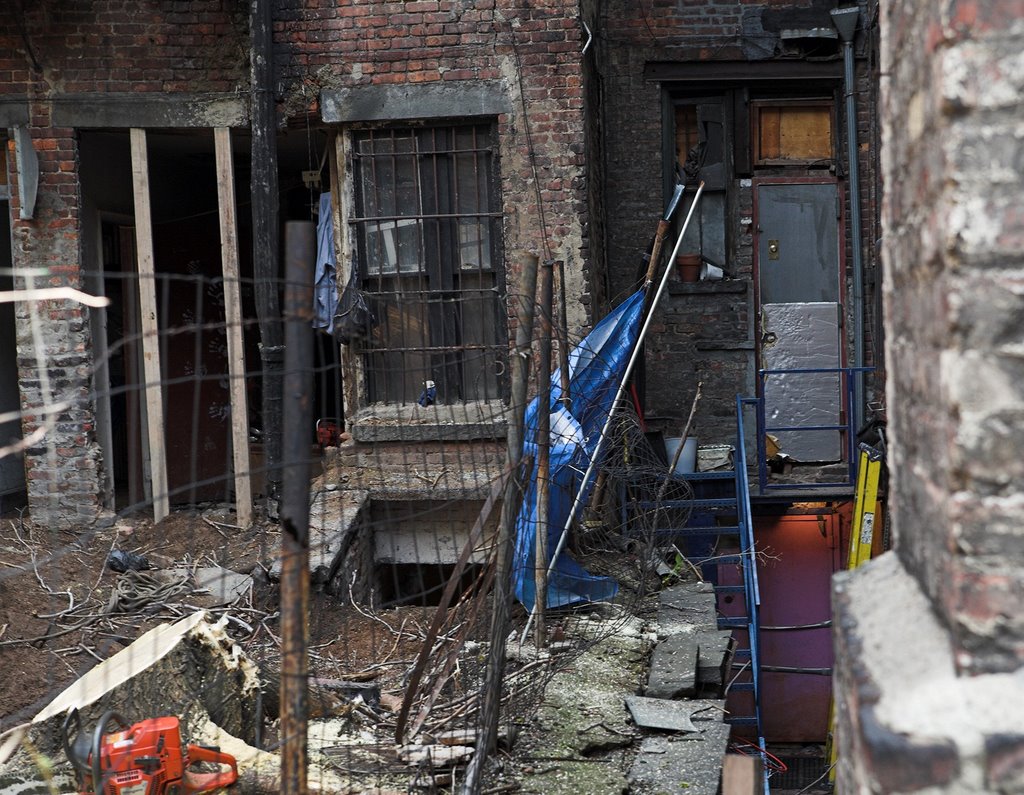
Polis has been following the story for us. This post gives the latest, as well as linking to the other updates.
Posted by Shin-pei at 3:27 PM 0 comments
4.17.2006
More Stone Streets in NYC

Stone Street, NYC - image source
Aaron Naparstek has a great article in NY Press about how we could pedestrianize NYC streets. I've been thinking a lot about how the city changes and what people fight for, and it's amazing how many times we're trying to get at the same thing, and how it seems like we're starting from zero each time. But it doesn't have to be that way!
Posted by Shin-pei at 11:46 AM 0 comments
Main street vs "lifestyle centers" vs shoppertainment

Image source
Just a quick update on the issue of Main Streets versus Malls, this time by the WSJ, just to put some business economics into it.
I'm so glad that "shoppertainment" may be reaching the end of its life!! It always felt funny that as a nation we would spend so much money and resources to create artificial "destination" experiences, like dining in faux rain forest restaurants. What both shoppertainment and lifestyle centers illustrate, to me anyway, is the deep appetite for genuine experiences, which can come from our traditional main streets and public markets, among other types of shopping typographies. That's still innovative (in the broad story of our civilization) and obviously still hard to get right! I still don't like the lifestyle center trend, which I think will also have its day of judgement, but at least it's a better reflection of where we want to end up.
Posted by Shin-pei at 11:29 AM 0 comments
4.16.2006
Beauty in the details

It's one of those quiet Sunday evenings when I have the TV on while I spend time on my computer, looking at things that I didn't have time to during the week. Tonight I was reminded of one of my favorite New York photographers, rion.nu, who recently moved to Paris. I'm going to miss the fabulous New York street photography (here's just a sample), but of course Paris is great for that too - so many beautiful details that make up the whole experience that is Paris. I'm looking forward to more.
Posted by Shin-pei at 8:29 PM 0 comments
4.14.2006
This year's Pritzker Prize

Brazilian Museum of Sculpture. Image from Archidose
Haven't seen much on this piece of news, though there was quite some hubbub when Thomas Mayne won it last year. (Could the Pritzker Prize site be any worse as a representation of a high design competition? I don't think it would take much to make a clean nice site.) This year's winner is Brazilian Paulo Mendes de Rocha, who's done a lot of work in Sao Paolo. I don't remember seeing anything that he's done when I was there. He's lauded for a humanist approach to concrete and steel - I would just love to see how that worked out. I can't tell from the photos at all - above.
Posted by Shin-pei at 11:30 AM 0 comments
Curating the city

Johnny's Coffeeshop, an "icon of Googie architecture on Wilshire's Miracle Mile"
Another online exhibit about the city, of a different kind. Los Angeles Conservancy's nifty web site, "Curating the City" can make anyone wax nostalgic about L.A., its boulevards and modernist architecture, no matter how much of a die-hard New Yorker you may be. (Anyone who's been there knows that sometimes, there ain't much to love about L.A. boulevards when you're sitting in the middle of afternoon traffic and the beautiful sunshine only seems to stir up more smog.)
Right now the focus is on Wiltshire Boulevard and the tour is available in English, Spanish and Korean. I also like the Memory Book, where you can submit your own stories of place.
The site looks great. But here's the thing: it seems that a preponderance of the buildings highlighted along the tour are exclusive (a la country club or office building). Few are real public spaces - though a boulevard is typically a city's easiest and most rarely pursued opportunity for a public space. At least the site will point out which public transit stop will take you to each place.
Posted by Shin-pei at 11:03 AM 0 comments
4.12.2006
Public Place

Someone here found this public input site for the Gowanus Canal. Public Place is run by NYU Wagner students who are focusing on the site as part of a Capstone project (I'm not sure what that means). I like the simplicity of the site - no posturing yet, and this makes it easier to give your opinion.
I always romaticize the Gowanus Canal. I've walked over the canal on warm summer evenings, and felt, just a little bit, like I'm in Amsterdam/Williamsburg. In reality, the place could use some help, though I'm always pleasantly surprised at how much community already exists through the long-time presence of the Brookyn Art Exchange (formerly the Gowanus Art Exchange) and other places. Also, one of my favorite painters, Dana Schutz supposedly has a studio there.
Posted by Shin-pei at 5:24 PM 0 comments
Hidden City Winners
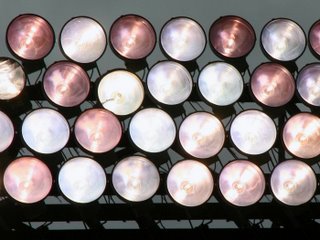
This one by Ohad, not sure if he's a winner but I liked it
Another fix: the winners of the Hidden City competition have been chosen (in my humble opinion one of the best contest ideas out there this year). There's a slow reveal, but in the meantime, you can revel in the Flickr pool - simply amazing.
Posted by Shin-pei at 11:57 AM 0 comments
Busy busy
Apologies for the lack of posts. We had a Board meeting earlier this week, and I have a writing deadline for the end of the week. Check out some of the links on the side to get your urban/public space fix.
Posted by Shin-pei at 11:45 AM 0 comments
4.05.2006
Breaking story on Mosaic Man!

Image source: pnelsoncomposer.com
All around the East Village, if you pay close attention (and sometimes not even), you'll see beautiful mosaics on streetlamp posts, embedded in the sidewalk, around doorways. They look as though they're made of found china, or tile, or any other similar material.
I had always been a fan, and was even more delighted when I got to the dog park one day with our little Miss C.S. and could see with my very eyes who was responsible for all these little intercessions of beauty.
Well, there's a breaking story on the home of the Mosaic Man. Geez. If his home is where I think it is, I saw him trying to set it up as an East Village Vets Center last summer.
Posted by Shin-pei at 9:50 PM 0 comments
Bryant Park treats bathroom-goers right (again)
Fresh flowers? Sounds very nice indeed (though I thought they always had that). The full take on the newly restored Bryant Park Public Restrooms.
Posted by Shin-pei at 12:17 PM 0 comments
Toll Brothers in New York
Lots on the entree of the luxury McMansion-trolling Toll Brothers into the New York City-proper market, courtesy of Polis, whose NY Times article got mentioned here and here, and yes, even a few more places.
(Sometimes, I loathe the responsibility of feeling like I should post what I'd like when everyone else is just posting exactly what I would want to post and my post is obviously redundant because there's not much more to say...this article being a good case in point.)
Posted by Shin-pei at 12:14 PM 1 comments
4.01.2006
A great thing about parks
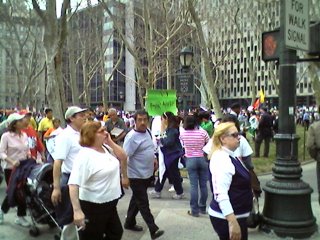
Terrible photo taken with my camera phone, sorry!
Every Saturday morning I walk to my yoga class at Dance New Amsterdam (formerly Danspace). I always have to try to figure out the least depressing way of walking through the Federal district and Foley Square, which seems to be filled with jersey barriers and chainlink fences that block off alternative entrances and extend curbs without any sidewalks. The green spaces seem gratuitous and the Marth Schwartz concentric-circle-seating-as-landscaping a pathetic antidote to all the gray that screams security, as much as I like the garish colors to break up the monotony.
When I walked down today, there were policemen milling about and setting up for something. There was a mobile stage and the streets were closed off. A concert? A police memorial?
I could hear the crowd even before I left the building after class. There were thousands of people walking down Centre Street, carrying flags from Brazil, the Dominican Republic, Peru, Mexico, Irish - these were just the few that I caught as they waved by. They were protesting the anti-immigration bill going through Congress.
The first major demonstration in which I took part was with my parents, in Taipei during a visit when I was in high school, and the 100,000 or so people with whom we walked could only converge at an intersection at the closed gate of a government building. The parks were closed to the demonstration, and the national army was posted along the route, not to protect the demonstrators, but to control them. It was the first time I saw machine guns. By nature of the design, the crowd had to break up at the endpoint. There was no place to gather.
By contrast, I could hear the loudspeakers in Thomas Paine Park (the link takes you to the Parks Dept page - there's apparently so little to say about the park that there's actually nothing to say) before I could actually see the park. Walking by the demonstration, I got a little teary thinking about how great it was that in New York City, anyone - citizen, immigrant, legal or not - could demonstrate and then converge on a City park and continue to interact and speak their mind. Where would they go to be heard if not for Foley Square and Thomas Paine Park in the middle of the Federal district?
Posted by Shin-pei at 8:56 PM 0 comments
